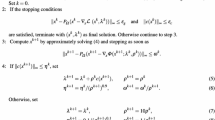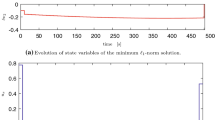Abstract
This paper describes the extension of a general purpose method for solving large sparse nonlinear programming problems to problems characterized by nonlinear least squares objective functions. The method incorporates a sequential quadratic programming algorithm which is solved using a multifrontal method for sparse symmetric indefinite linear equations in conjunction with a Schur-complement technique for solving the quadratic programming subproblem. To demonstrate the utility of the tool the algorithm is used to solve both linear and nonlinear least squares problems which arise in trajectory design. An approach for approximating tabular data which minimizes the curvature subject to interpolation and monotonicity constraints requires the solution of a large sparse linear least squares problem. Finally, the utility of the tool for solving nonlinear least squares problems which arise from prescribed path trajectory design is demonstrated.
Access this chapter
Tax calculation will be finalised at checkout
Purchases are for personal use only
Preview
Unable to display preview. Download preview PDF.
Similar content being viewed by others
References
C. Ashcraft; A vector implementation of the multifrontal method for large sparse, symmetric positive definite linear systems, Technical Report ETA-TR-51, Boeing Computer Services, 1987.
C. Ashcraft and R. Grimes; The influence of relaxed supernode partitions on the multifrontal method, Technical Report ETA-TR-60, Boeing Computer Services, 1988.
J. Betts; Using sparse nonlinear programming to compute low thrust orbit transfers, J. Astro. Sci. 41, 1993, 349–371.
J. Betts and P. Frank; A sparse nonlinear optimization algorithm, J. Optim. The. Appl. 82, 1994.
J. Betts and W. Huffman; The application of sparse nonlinear programming to trajectory optimization, J. Guid. Cont. Dynam. 15, 1992.
J. Betts and W. Huffman; Path constrained trajectory optimization using sparse sequential quadratic programming, J. Guid. Cont. Dynam. 16, 1993, 59–68.
A. Bryson, M. Desai, and W. Hoffman; Energy-state approximation in performance optimization of supersonic aircraft, J. Aircraft 6 1969.
P. Gill, W. Murray, M. Saunders, and M. Wright; Some theoretical properties of an augmented Lagrangian merit function, Report SOL 86-6, Department of Operations Research, Stanford University, 1986.
C. de Boor; A Practical Guide to Splines, Springer, New York, 1978.
P. Gill, W. Murray, M. Saunders, and M. Wright; A Schur-complement method for sparse quadratic programming, Report SOL 87-12, Department of Operations Research, Stanford University, 1987.
M. Heath; Numerical methods for large sparse linear least squares problems, SIAM J. Scien. Stat. Comp. 5 1984, 497–513.
Author information
Authors and Affiliations
Editor information
Editors and Affiliations
Rights and permissions
Copyright information
© 1995 Springer Science+Business Media New York
About this paper
Cite this paper
Betts, J.T. (1995). The Application of Sparse Least Squares in Aerospace Design Problems. In: Borggaard, J., Burkardt, J., Gunzburger, M., Peterson, J. (eds) Optimal Design and Control. Progress in Systems and Control Theory, vol 19. Birkhäuser, Boston, MA. https://doi.org/10.1007/978-1-4612-0839-6_5
Download citation
DOI: https://doi.org/10.1007/978-1-4612-0839-6_5
Publisher Name: Birkhäuser, Boston, MA
Print ISBN: 978-1-4612-6916-8
Online ISBN: 978-1-4612-0839-6
eBook Packages: Springer Book Archive




